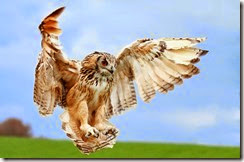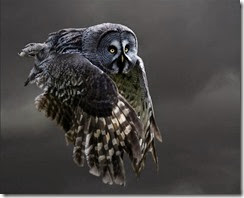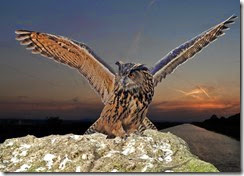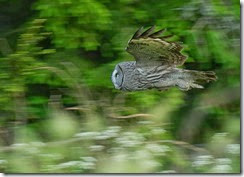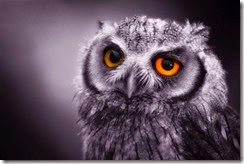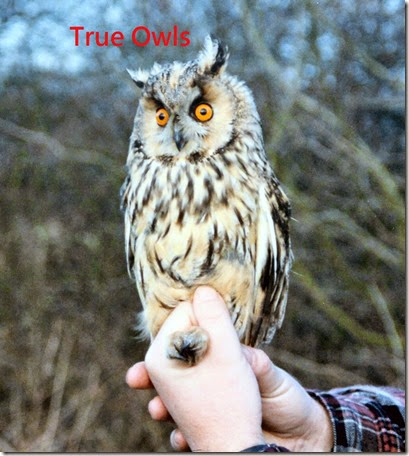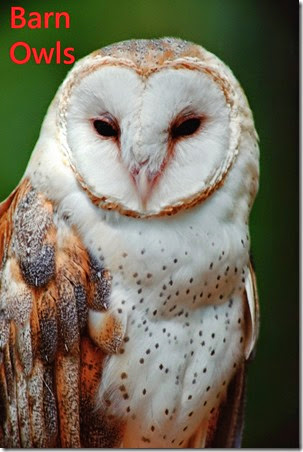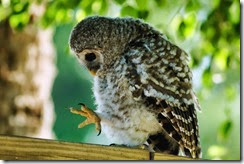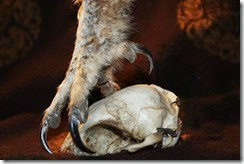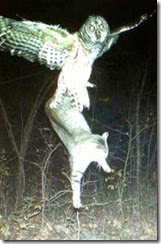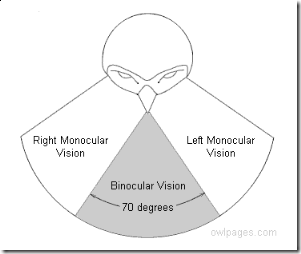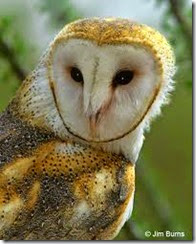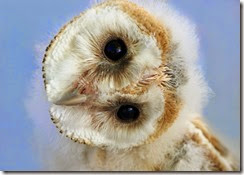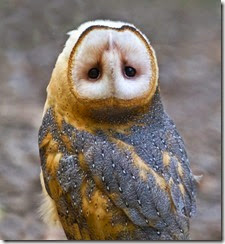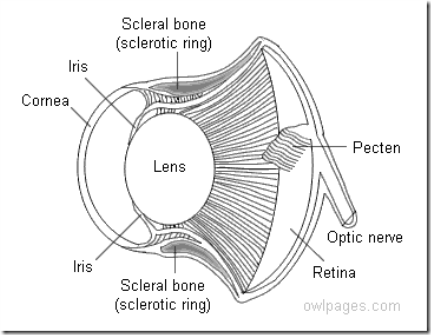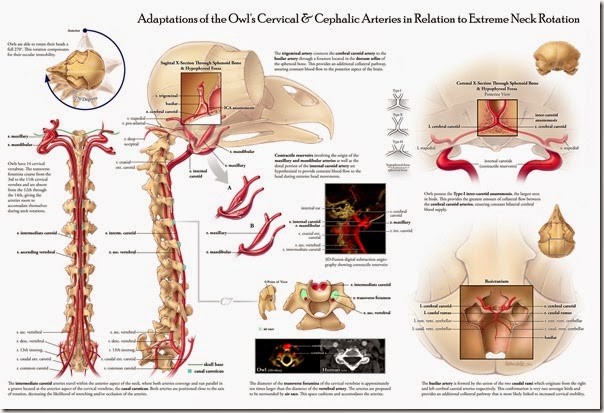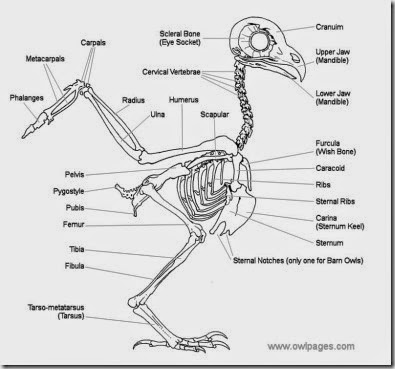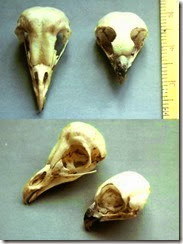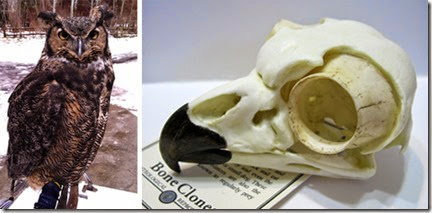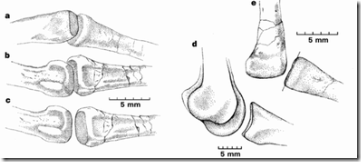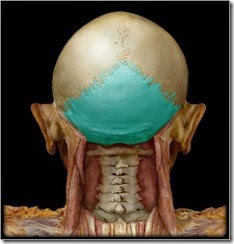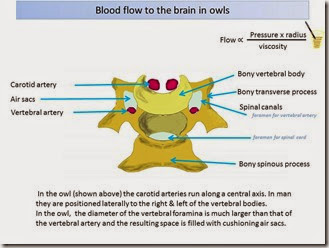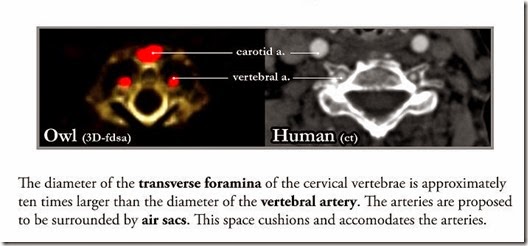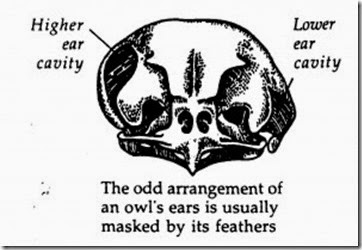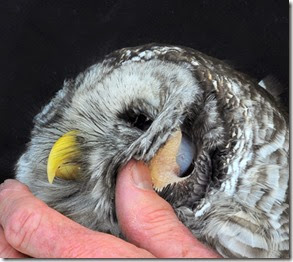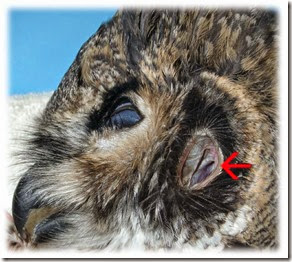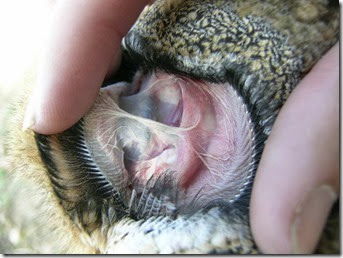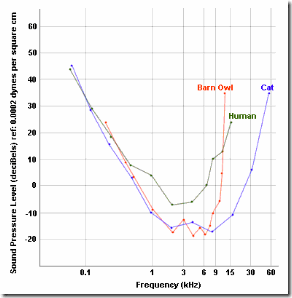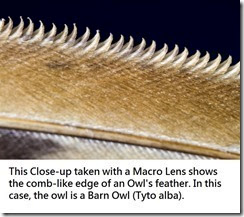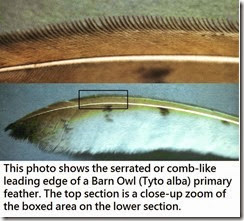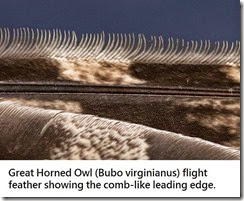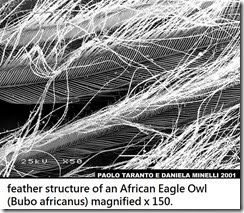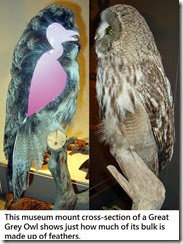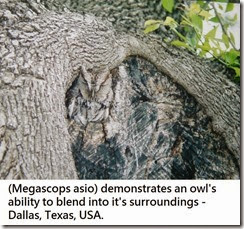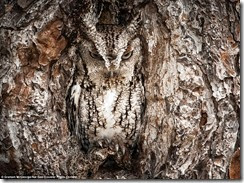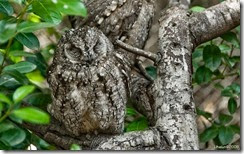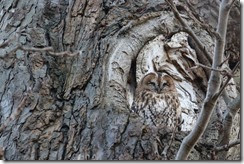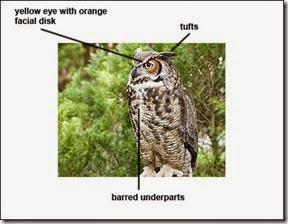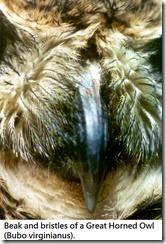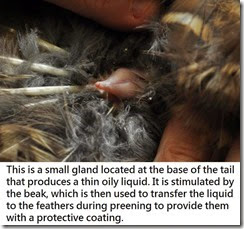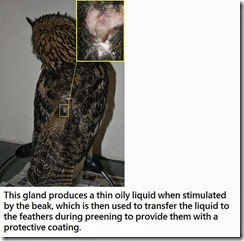Referring to the top 10 cute animals – earth unplugged
http://youtu.be/MepHOlXh-w0
Now, I would love to have a look on the no. 5 cute animal - the Owl that Ms. Maddle mentioned on her above video:
1. Owls belong to the Order Strigiformes (鴞形目).
The Order Strigiformes is further divided into two families, the barn owls (Family Tytonidae) and the typical owls (Family Strigidae). Owls are a diverse group of birds, with over 220 species of owls belonging to the Order Strigiformes.
有趣:
1. A. 貓頭鷹有兩大家族: the barn 糧倉owls (Family Tytonidae) , and the typical 典型 / True owls (Family Strigidae).
B. 點解會叫: 糧倉貓頭鷹? 原來這種貓頭鷹喜歡在糧倉閣樓建巢.
http://www.owlpages.com/owls.php?genus=Tyto&species=alba
These pale, nearly worldwide birds are closely associated with man through their traditional use of barn lofts and church steeples as nesting sites
然而, 牠們的學名Tyto alba卻是白貓頭鷹 : Tyto是希臘文的貓頭鷹. alba是拉丁文的白.
http://en.wikipedia.org/wiki/Barn_owl
The barn owl's scientific name, established by G.A. Scopoli in 1769, literally means "white owl", from the onomatopoetic Ancient Greek tyto (τυτο) for an owl – compare English "hooter" – and Latin alba, "white"
----------------------------------------------------------------------------------------------
http://twistedsifter.com/2010/08/10-facts-about-owls/
2. The structure of an owl’s foot is referred to as zygodactyl (攀木頖鳥, 腳掌前後有雙趾的).
This means that two of the toes face forward while two face backward. This arrangement enables the owls to capture and grasp prey with greater ease. Sometimes, the third toe can be rotated forward into a position occasionally used for perching棲息.
http://en.wikipedia.org/wiki/Owl
Talons爪
While the auditory and visual capabilities of the owl allow it to locate and pursue its prey, the talons and beak of the owl do the final work. The owl kills its prey by using these talons to crush the skull and knead the body.[16] The crushing power of an owl’s talons varies according to prey size and type, and by the size of the owl. Theburrowing owl (Athene cunicularia), a small partly insectivorous owl, has a release force of only 5 N. The larger barn owl (Tyto alba) needs a force of 30 N to release its prey, and one of the largest owls, the great horned owl (Bubo virginianus) needs a force of over 130 N to release prey in its talons.[20] An owl’s talons, like those of most birds of prey, can seem massive in comparison to the body size outside of flight. The masked owl has some of the proportionally longest talons of any bird of prey; they appear enormous in comparison to the body when fully extended to grasp prey.[21] An owl’s claws are sharp and curved. The family Tytonidae have inner and central toes of about equal length, while the family Strigidae have an inner toe that is distinctly shorter than the central one.[20] These different morphologies allow efficiency in capturing prey specific to the different environments they inhabit.
有趣:
2. A. 牠們爪部有4腳趾. 兩前兩後. 方便牠們獵食時的急速捕捉食物的. 第3趾是可以轉向前, 來抓住樹幹停留, 當如有需要時.
B. 牠們的爪是非常強而有力的, 比較細小的貓頭鷹, 你要用5N ( N=newtons, m = w/g = (5 N) / (9.81 m/s²) = 0.50 kg 去打開牠的爪來奪取牠的食物. 大一點如barn owl 就要30 N 了, 就是3.1kg的力. 再大到如horned owl, 就要超過130N, 13公斤的力了. 貓頭鷹一定要有咁大力才可用爪來壓碎獵物的頭腦捏圓或扁獵物的身體.
C. 牠們的趾甲也非常銳利和彎曲.
3. Owls are birds of prey(食肉烏).
Owls feed on a wide variety of prey including mammals, other birds, insects, and reptiles. There are even some species of owls that live in Africa and Asia that feed on birds. Owls cannot chew their prey since, like all birds, they do not have teeth. Instead, they swallow small prey whole and must tear larger prey into smaller pieces before swallowing. They later regurgitate pellets of indigestible material such as bone, fur, and feathers.
有趣:
3. A. 貓頭鷹的食物包括: 哺乳動物, 鳥, 昆蟲, 魚和爬虫類等等, 因為貓頭鷹跟鳥類一樣, 牠們是沒有牙齒的, 所以牠們必須先用爪將食物撕碎成細塊吞食, 並且稍後會反芻那些難消化食物, 如骨, 羽毛和毛革等等.
4. Owls’ eyes are fixed in their sockets (眼窩).
http://www.owlpages.com/articles.php?section=owl+physiology&title=vision
Of all an Owl's features, perhaps the most striking is its eyes. Large and forward facing, they may account for one to five percent of the Owl's body weight, depending on species. The forward facing aspect of the eyes that give an Owl its "wise" appearance, also give it a wide range of "binocular" vision(seeing an object with both eyes at the same time). This means the owl can see objects in 3 dimensions (height, width, and depth), and can judge distances in a similar way to humans. The field of view for an owl is about 110 degrees, with about 70 degrees being binocular vision.
有趣:
4. A. 貓頭鷹的眼睛是不能轉動的, 是固定在眼窩.
B. 貓頭鷹眼睛之大, 是佔牠體重1-5%.
C. 兩眼睛是可以同時望到同一物件在三維 (高, 寬和深), 並且可以立即猜測到物件的距離.
D. 上圖: 貓頭鷹兩眼睛共看到110度 the view angle (左眼20度, 右眼20度, 兩眼向前有70度, 共110度) , 人類的眼界範圍是180度 (左眼20度, 右眼20度, 兩眼向前有140度, 共180度). 然而烏類的雙眼睛卻可一齊向前看, 又可分別單獨看. 在 birdnote.org 烏類的眼是3倍更銳利清晰過人類. 因為各眼在頭的兩邊, 他們可以一齊看, 又可分別看, 所以當然是360度全看了.
All birds have the fascinating ability to see in what is termed binocular and monocular vision. This simply means birds eyes work together as a pair to see straight ahead, but each eye can also see independently of the other eye. This monocular vision is the reason for the varying placement of the eyes on different bird species.
For instance, the pigeon has eyes on the side of its head. This placement gives them the amazing capability of seeing almost everywhere around them. The only place they can't see is directly behind them. The American woodcock's eyes are situated closer to the top of the head and can therefore see what's behind it! This bird can still see what is in front and above the head as well.
http://voices.yahoo.com/the-fascinating-eyesight-birds-357295.html?cat=70
http://birdnote.org/show/birds-eye-view-i
http://birdnote.org/show/birds-eye-view-ii
By comparison, humans have a field of view that covers 180 degrees, with 140 degrees being binocular. A woodcock has an amazing 360 degree field of view, because its eyes are on the side of its head. However, less than 10 degrees of this is binocular.
An Owl's eyes are large in order to improve their efficiency, especially under low light conditions. In fact, the eyes are so well developed, that they are not eye balls as such, but elongated tubes. They are held in place by bony structures in the skull called Sclerotic rings. For this reason, an Owl cannot "roll" or move its eyes - that is, it can only look straight ahead!
The Owl more than makes up for this by being able to turn its head up to 270 degrees left or right from the forward facing position, and almost upside down ( barn-owl can turn its head 180 degrees). There are several adaptations that allow this, outlined in the Owl Skeletal system article.
有趣:
4. E. 貓頭鷹的眼睛是不能轉動並且固定在眼窩上, 要能在黑夜出動捕食, 牠的頭部必須作出配合了, 所以牠頭部不單左右轉動270度, 還可正面上下轉180度.
As most owls are active at night, their eyes must be very efficient at collecting and processing light. This starts with a large cornea 眼角膜(the transparent outer coating of the eye) and pupil (the opening at the centre of the eye). The pupil's size is controlled by the iris 虹膜(the coloured membrane suspended between the cornea and lens). When the pupil is larger, more light passes through the lens and onto the large retina 視網膜(light sensitive tissue on which the image is formed).
The retina of an owl's eye has an abundance of light-sensitive, rod-shaped cells appropriately called "rod" cells. Although these cells are very sensitive to light and movement, they do not react well to colour. Cells that do react to colour are called "cone" cells (shaped like a cone), and an Owl's eye possesses few of these, so most Owls see in limited colour or in monochrome.
Since Owls have extraordinary night vision, it is often thought that they are blind in strong light. This is not true, because their pupils have a wide range of adjustment, allowing the right amount of light to strike the retina. Some species of Owls can actually see better than humans in bright light.
To protect their eyes, Owls are equipped with 3 eyelids. They have a normal upper and lower eyelid, the upper closing when the owl blinks, and the lower closing up when the Owl is asleep. The third eyelid is called a nictitating 眨眼 membrane薄膜, and is a thin layer of tissue that closes diagonally across the eye, from the inside to the outside. This cleans and protects the surface of the eye.
有趣:
4. F. 貓頭鷹的眼睛結構如上圖, 因為晚間捕食, 所以眼睛必須對光有效率地收集和處理. 貓頭鷹對眼有一種"rod"細胞, 對光和移動物件都非常敏感, 可是這種細胞卻對顏色卻反應較差, 於是大部分的貓頭鷹都是睇到極有限的顏色, 甚至只是單色圖而已.
G. 貓頭鷹有3片眼簾. 上眼簾閉上時, 是當貓頭鷹眨眼. 下眼簾閉上時, 是當貓頭鷹在睡覺. 第3片眼簾 對角線地閉上 (看以下片段, 便知道, 第3片眼簾是隱藏在眼角, 當要清潔眼睛表面時, 便會很快的向眼尾掃去. 貓頭鷹片段可能不太明顯, 大家可看看大象的片段, 第3片眼簾的動作是一樣的.)
5. Owls' head turning ability 貓頭鷹頭部可以270度轉動的原因:
http://www.owlpages.com/articles.php?section=Owl+Physiology&title=Skeleton#headturn
An Owl's skeleton is typical for birds. Designed for both walking and flying, it is very light and strong. In owls, the skeleton makes up about 7-9% of its total body weight. Many of the bones which would be separated in mammals are fused together in birds, making them strong to support their weight on the ground. In addition, some of the larger bones are hollow, with bony internal bracing. This helps reduce overall weight.
Several Owl species have obviously asymmetrical 不對稱skulls, which is an adaptation to for directional hearing.
An owl can turn its head up to 270 degrees left or right from the forward facing position. An owl cannot turn it's head full circle from a forward facing position as is the common belief. There are several adaptations that allow this:
1) An owl's neck has 14 vertebrae, which is twice as many as humans.
2) Owls have only one occipital articulation with the cervical vertebrae. (There is only one bone situated on top of the backbone.) Humans have two articulations. This allows the owl to pivot on the vertebrae column much like your body can pivot on one foot. Their muscle structure is arranged in a manner that allows this movement as well.
3) Owls have a special arrangement of the jugular veins (靜脈)with associated bypass connector blood vessels, to ensure that blood supply (and return) are not impeded as the neck is rotated.
The large flat breastbone, or Sternum, supports the large and powerful flight muscles. It also protects the heart, lungs and other internal organs. In the Tytonidae family of owls, the Carina, or Sternum Keel is broad, becoming narrower towards the abdomen, and the lower edge of the sternum has only small notches on each side. In the family Strigidae, the carina is narrow at its upper part, and becomes broader towards the belly, while the lower edge of the sternum has two deep notches on each side.
The wing bones are relatively long in owls, and the associated wing surface area is broad, producing a low wing loading. This allows for easy take-offs, and effortless flight, even when carrying prey.
The foot bones, or tarso-metatarsi, are relatively short and stout in owls, most likely to aid in the efficient killing and carrying of prey.
The most striking team finding came after researchers injected dye into the owls' arteries(動脈) , mimicking blood flow, and manually turned the animals' heads. Blood vessels at the base of the head, just under the jaw bone, kept getting larger and larger, as more of the dye entered, and before the fluid pooled in reservoirs. This contrasted starkly with human anatomical ability, where arteries generally tend to get smaller and smaller, and do not balloon as they branch out.
Researchers say these contractile blood reservoirs act as a trade-off, allowing owls to pool blood to meet the energy needs of their large brains and eyes, while they rotate their heads. The supporting vascular network, with its many interconnections and adaptations, helps minimize any interruption in blood flow.
"Our in-depth study of owl anatomy resolves one of the many interesting neurovascular medical mysteries of how owls have adapted to handle extreme head rotations," says de Kok-Mercado, now a scientific illustrator and animator at the Howard Hughes Medical Institute.
Moreover, says Gailloud, "our new study results show precisely what morphological adaptations are needed to handle such head gyrations and why humans are so vulnerable to osteopathic injury from chiropractic therapy. Extreme manipulations of the human head are really dangerous because we lack so many of the vessel-protecting features seen in owls."
The first anatomical variation they discovered was in the owl neck, where one of the major arteries feeding the brain passes through bony holes in the vertebrae. The hollow cavities were approximately 10 times larger in diameter than the vertebral artery traveling through it. The researchers say the extra space in the transverse foraminae, as the holes surrounding the vertebral arteries are known, creates a set of cushioning air pockets that allow the artery to move around when twisted. Twelve of the 14 cervical vertebrae in the owl's neck were found to have this adaptation.
"In humans, the vertebral artery really hugs the hollow cavities in the neck. But this is not the case in owls, whose structures are specially adapted to allow for greater arterial flexibility and movement," says de Kok-Mercado.
The team also found that the owl's vertebral artery enters the neck higher up than in other birds - going in at the owl's 12th cervical vertebrae instead of the owl's 14th cervical vertebrae - allowing for more vessel room and slack.
Among de Kok-Mercado and Gailloud's other findings were small vessel connections between the carotid (頸動物) and vertebral arteries - not usually seen in adult humans - that allow blood to be exchanged between the two blood vessels. The researchers say these so-called anastomoses, including a vessel connection called a patent trigeminal artery, allow for uninterrupted blood flow to the brain, even if one route is blocked during extreme neck rotation.
貓頭鷹頭部可以270度轉動的原因:
有趣:
5. A. 貓頭鷹頸部有14塊椎骨, 比人類多出一倍.
B. 貓頭鷹頸部只有一塊枕骨與頸椎骨連接, 情況就如人類膝蓋(如下圖) 後, 轉動角度就大好多了, 但人類的頸枕骨卻是兩片連一起,來支持我們的頭部, 也是妨礙了頭部可轉動更大的角度.
C. 貓頭鷹頸部下巴的動脈會在頭部轉動時, 圑聚大量血液 ( 血管腫脹起來) 來應付牠頭部在轉動時, 腦部, 眼睛等等的力量來源.
D. 横切面的椎間孔的直徑是頸部椎骨動脈的直徑的十倍大. 而動脈受到周圍的氣囊所包圍, 就像墊一樣的保護著. 使得貓頭鷹頭部轉動時而不受到損害. 貓頭鷹14塊頸部椎骨就有12塊是這種結構. 人類的動脈卻縛緊在頸椎骨的空洞內.
E. 貓頭鷹頸動脈是比起其它鳥類, 早兩節椎骨離開頸椎骨(即14節椎骨, 動脈就在第12節離開) 後接上頭部, 使得頭部更有空間和鬆動可以轉來轉去.
6. Hearing 聽力:
http://www.owlpages.com/articles.php?section=owl+physiology&title=hearing
Because Owls are generally active at night, they have a highly developed auditory (hearing) system. The ears are located at the sides of the head, behind the eyes, and are covered by the feathers of the facial disc. The "Ear Tufts" visible on some species are not ears at all, but simply display feathers.
The shape of the ear opening (known as the aperture) depends on the species of Owl - in some species, the opening has a valve瓣膜, called an operculum 鰓蓋covering it . The opening varies from a small, round aperture to an oblong slit with a large operculum. All owls of the family Tytonidae have rounded openings with large opercula, while in Strigidae, the shape of the outer ear is more varied.
An Owl's range of audible sounds is not unlike that of humans, but an Owl's hearing is much more acute at certain frequencies enabling it to hear even the slightest movement of their prey in leaves or undergrowth.
Some Owl species have asymmetrically 不對稱地set ear openings (i.e. one ear is higher than the other) - in particular the strictly nocturnal species, such as the Barn Owl or the Tengmalm's (Boreal) Owl. These species have a very pronounced facial disc, which acts like a "radar dish", guiding sounds into the ear openings. The shape of the disc can be altered at will, using special facial muscles. Also, an Owl's bill 鳥嘴is pointed downward, increasing the surface area over which the soundwaves are collected by the facial disc. In 4 species (Ural, Great Gray, Boreal/Tengmalm's & Saw-whet), the ear asymmetry is actually in the temporal parts of the skull, giving it a "lop-sided" 不平衡的appearance.
An Owl uses these unique, sensitive ears to locate prey by listening for prey movements through ground cover such as leaves, foliage, or even snow. When a noise is heard, the Owl is able to tell its direction because of the minute time difference in which the sound is perceived in the left and right ear - for example, if the sound was to the left of the Owl, the left ear would hear it before the right ear. The Owl then turns it's head so the sound arrives at both ears simultaneously - then it knows the prey is right in front of it. Owls can detect a left/right time difference of about 0.00003 seconds (30 millionths of a second!)
An Owl can also tell if the sound is higher or lower by using the asymmetrical or uneven Ear openings. In a Barn Owl, the left ear left opening is higher than the right - so a sound coming from below the Owl's line of sight will be louder in the right ear.
The translation of left, right, up and down signals are combined instantly in the Owl's brain, and create a mental image of the space where the sound source is located. Studies of Owl brains have revealed that the medulla (the area in the brain associated with hearing) is much more complex than in other birds. A Barn Owl's medulla is estimated to have at least 95,000 neurons 神經元- three times as many as a Crow烏鴉.
Once the Owl has determined the direction of its next victim, it will fly toward it, keeping its head in line with the direction of the last sound the prey made. If the prey moves, the Owl is able to make corrections mid flight. When about 60 cm (24") from the prey, the Owl will bring its feet forward and spread its talons in an oval pattern, and, just before striking, will thrust it's legs out in front of it's face and often close it's eyes before the kill.
http://video.nationalgeographic.com/video/worlds-deadliest-ngs/deadliest-owl
對於要在黑夜獵食的貓頭鷹, 除了視力和爪力外, 聽力也不能缺少:
有趣:
6. A. 貓頭鷹耳朵的構造是奇特的, 是在頭部的左右兩邊, 一上一下, 位置並不對稱的. 好處就是可以收集不同方位的聲音. 舉例: 當聲音來自左邊, 左邊耳先收到音訊, 貓頭鷹便轉動頭部, 當聲音是同步到達雙耳, 即是說獵物就在正中前面了. 在0.00003 秒間, 貓頭鷹就可以在0.00003 seconds (30 millionths of a second!)立即洞察到這左到右的聲音來源, 而立即分析到獵物方向.
6. B. 同樣是跟以上解說有相同的道理, 因為左耳高, 右耳低, 於是當聲音來自視線之下時, 右耳一定大聲過左耳了. 因此貓頭鷹可以立即分析到獵物方向.
6. C. 所有這些聲音來源經過左右耳至到大腦的 medulla, 在medulla 有最少95,000神經元, 比烏鴉多出3倍.
6. D. 另外, 除了以上所說外, 貓頭鷹臉大如一雷達天線碟般, 加上臉部肌肉的動作等, 能收集聲源進入耳朵.
7. Flight and feathers 飛行和羽毛
http://www.owlpages.com/articles.php?section=owl+physiology&title=Feathers
Birds have up to five feather types:
1. Contour feathers cover the body, wing (remiges) and tail (rectrices).
2. Down feathers - these soft and fluffy feathers trap air and create a layer of insulation next to the bird's body.
3. Semiplumes function to fill in between contour and down feathers.
4. Bristles are small feathers with a stiff shaft and barbs only on the base, or often not at all. Bristles occur most commonly around the base of the bill, around the eyes, and as eyelashes.
5. Filoplumes are hairlike feathers that consist of a very fine shaft with a few short barbs at the end. They are typically covered by other feathers, and may function as pressure and vibration receptors - they sense the location of other feathers so they can be adjusted properly.
An Owl has very few down feathers, but has downy barbules on the parts of the contour feathers closest to the skin.
Many of the Owl's feathers are specially designed - around the face there are the stiff facial disc feathers or ruff, crown feathers, ear-flap feathers and also bristles around the bill.
The feet and bill have Filoplumes that work somewhat like feelers觸鬚, to help the Owl react to things they touch, such as prey.
The most unique adaptation of Owl feathers is the comb-like or fimbriate (fringe-like) leading edge of the primary wing feathers referred to as "flutings" 刻凹槽or "fimbriae"毛缘. With a normal bird in flight, air rushes over the surface of the wing, creating turbulence湍流, which makes a gushing noise. With an Owl's wing, the comb-like feather edge breaks down the turbulence into little groups called micro-turbulences. This effectively muffles压抑 the sound of the air rushing over the wing surface and allows the Owl to fly silently. There is also an alternate theory that the flutings actually shift the sound energy created by the wingbeats to a higher frequency spectrum辐射源, where most creatures (including prey and humans) cannot hear.
Silent flight gives Owls the ability to capture prey by stealth, and also allows the Owl to use its hearing to locate potential prey. This adaptation is not present on some Owl species that hunt in the daytime.
好了, 貓頭鷹聽到獵物所在, 當然就必須趕緊飛去捉住獵物, 這樣就必須要提到牠的羽毛如何幫助牠飛行了.
有趣:
7. A. 貓頭鷹有5種不同的羽毛, 功能除了1. 保暖外, 牠羽毛特別的梳邊和刻凹槽結構是可以 2. 抑壓飛行時發出聲音. 並且 3. 在腳上和在它嘴邊毛就跟觸鬚般敏銳, 當他們捉到獵物時使牠們可以反應非常快.
7. B. 另一學說, 牠羽毛特別的梳邊和刻凹槽結構是可以改變了由翼拍動時發出聲音的音頻, 使得音頻高出牠獵物或人類可以聽到的音頻.
8. Pattern and Colour 圖樣和顏色
In general, an Owl's cryptic colours and pattern allow it to blend in with its surroundings, hiding it from potential danger. This is especially important for the nocturnal owls, as they need to remain hidden when roosting in the daytime.
When threatened, an owl will often take up a concealing posture, with closed eyes, raised ear tufts, and compacted feathers.
The ear tufts are actually nothing to do with hearing, they are display feathers, used to indicate moods, such as fear, anger and excitement. They also help with camouflage偽裝. It is also interesting to note that although owls of the same species look alike, each individual owl within a species has slightly different markings.
貓頭鷹的羽毛的圖樣和顏色都是有保護的功用.
有趣:
8. A. 看上圖就知道, 貓頭鷹的羽毛的圖樣和顏色是可以完全隱藏在背景之中的.
8. B. ear tufts 原來跟聽覺無關的. 它是用來表達心情的, 是恐懼, 是憤怒, 又或是興奮. 並且也可以用來偽裝. 因為當受嚇的時候, 貓頭鷹會立即開始隱藏自己在背景中, 它敝上一對大眼, ear tufts 升起, 所有羽毛壓緊.
9. Preening 用嘴整理羽毛
All birds frequently clean and groom their feathers in order to remove dust, dirt and parasites寄生物. Owls, like most other birds, use their beak and talons to do this. The two outer talons on the owls feet are the "feather combs". The sharp medial edge of these outer talons enables them to clean their heads.
Flight feather barbs倒钩 have tiny barbules 魚鬚 that lock the barbs together, making the feather into a single continuous surface. These barbules often become unhooked during harsh粗糙的 flying conditions or collisions碰撞. A bird will use its beak to realign 重新排列the unhooked barbs and restore the feather to peak 最頂condition.
There is small gland called the uropygial, located at the base of the tail, that produces a thin oily liquid. This gland is stimulated by the beak, which is then used to transfer the liquid to the feathers to provide them with a protective coating.
有趣:
9. A. 貓頭鷹尾的底部有一細小乳腺, 用來分泌薄薄的油液, 由嘴巴刺激而分泌, 再由嘴巴 preening 時, 將油液擦到羽毛上去, 成為一層保護膜.
9. B. 貓頭鷹整理羽毛時的動作和形態, 是跟小鳥大致一樣的.
Boreal Owl Preening in Forest -Raw footage from Dale Bohlke on Vimeo.
10. Molting 換毛
When an Owl hatches孵化, it has no flight feathers, but is covered with downy feathers that keep it warm. This down is gradually replaced with feathers as the Owl grows. Juvenile 年青時 plumage 羽衣is similar to adult's, but often paler, and sometimes with different markings.
An adult bird's colour is derived from mature feathers. During the normal course of the bird's life, these feathers suffer from damage caused by abrasion, flexing and even collisions.
Like other birds, Owls regularly replace their feathers in a process known as molting. This usually happens once a year, beginning after the parent birds have raised a brood 孵蛋 that has fledged 長羽毛and can care for themselves.
The process takes up to 3 months, during which feathers are shed 脱落and re-grown over the entire body in a regular pattern. In order to minimise the impact of the molt on the Owl's flight and hunting skills, this molting pattern only allows a few of the primary or secondary flight feathers to be shed at time.
With the exception of the Barn Owl, molting of wing feathers is from the inside out. Barn Owl wing feathers are replaced from the middle of the wing out (in both directions). Tail feathers also drop out a few at a time, except in some smaller Owl species, who loose all the tail feathers at once.
When birds molt, new feathers grow to replace the ones that have fallen out. The new feathers immerge from the skin tightly bound in a thin shaft of tissue. These are called pin feathers. The shaft splits shortly after, allowing the new feather to unfurl 張開and grow to its full size.
11. Flight 飛行
Most owls have relatively large, rounded wings. The wings are broad, with a large surface area relative to the weight of the bird i.e. a low wing loading. This allows them to fly buoyantly and effortlessly, without too much flapping and loss of energy. They can glide easily and fly slowly for long periods of time. Many species use this slow flight to hunt ground-dwelling prey from the air.
12. Owls create a variety of vocalizations. 多種類發聲法
Owls create a wide variety of sounds or vocalizations. The familiar hoot is usually a territorial declaration, though not all species are able to hoot. Other sounds owls might make include screeches, hisses, and screams.
13. Most owls are nocturnal. 夜間活動
Most owls are active at night. A few species (such as the pygmy owls) are active in the early morning or at dusk while some (such as the burrowing owl and the short-eared owl) are active during the day.
14. Owls are found in all regions of the Earth except Antarctica, most of Greenland and some remote islands.
Further more:
What does a Barn Owl sound like?
http://www.mirror.co.uk/news/weird-news/looking-right-twit-owl-turns-1861289
http://voices.yahoo.com/the-fascinating-eyesight-birds-357295.html?cat=70
For the number 10, The Snow Leopard, I did write a blog as following:
http://meiwechner2099.blogspot.com.au/2014/05/snow-leopards-purr.html
For the number 9, The Clown fish , I did write a blog as following:
http://meiwechner2099.blogspot.com.au/2014/05/clown-fish_17.html
For the number 8, The Chipmunk , I did write a blog as following:
http://mei-mei-wechner.blogspot.com.au/2014/05/chipmunk.html
For the number 7, The pygmy leaf chameleon , I did write a blog as following:
http://mei-mei-wechner.blogspot.com.au/2014/05/pygmy-leaf-chameleon-bearded-leaf.html
For the number 6, The Red Panda , I did write a blog as following:
http://meiwechner2099.blogspot.com.au/2014/05/red-panda.html?view=magazine






